Grand Sumo Tournament 大相撲
|
|
|

Grand sumo tournaments are held six times a year in Jan., March, May, July, Sept., and Nov. They are held at Ryogoku Kokugikan arena in Tokyo in Jan., May, and Sept. In March, it is in Osaka, July in Nagoya, and Nov. in Fukuoka. This is the Kokugikan.
|
|

Each tournament is 15 days long, and each wrestler in the top two divisions wrestle once a day. A wrestler must win at least 8 times during a tournament to get promoted. Otherwise, he is demoted in rank. The more he wins, the higher he is promoted.
|
|

There are about 800 sumo wrestlers, called rikishi, and they belong to one of six divisions. Each day of the tournament starts in the morning with the lower divisions as you see here. They are skinnier and wear drab-looking black mawashi.
|
|

The sumo matches have five judges (shinpan), dressed in formal black kimono, sitting on each of the four sides of the sumo ring. There is also a referee (gyoji) on the ring. This is former yokozuna Takanohana who has lost much weight and looks like a kid.
|
|

One colorful highlight each day during a tournament is the dohyo-iri ring-entering ceremony performed by rikishi in the top two divisions. These are rikishi in the second highest division called Juryo. 十両
|
|

Juryo wrestlers performing the ring-entering ceremony.
|
|

The wrestlers are divided into east and west, and both groups perform the dohyo-iri. They wear colorful ceremonial aprons called kesho mawashi made of silk. They can cost up to 500,000 yen.
|
|

You can see sumo for as cheap as 2100 yen. You can buy tickets at the box office where the tournament is held. The cheap tickets may sell out, so go early.
|
|

JUryo wrestlers continue to fight.
|
|

This is Hakurozan, who was arrested for drug use in 2008 and booted out of sumo along with his brother Roho.
|
|

On the first day of the tournament, the chairman of the Japan Sumo Association (shown here is Kitanoumi) and top rikishi go on the ring to convey greetings to the crowd.
|
|

The chairman of the Japan Sumo Association (shown here is Kitanoumi) greets the crowd and thanks everyone for coming.
|
|

Next we have the ring-entering ceremony by the top division wrestlers in the Makunouchi Division. Rikishi from the east side come down the aisle first. They are led by a referee.
|
|

They enter as wooden clappers are clapped by someone.
|
|

The colorful kesho mawashi are expensive to make, and each wrestler has a sponsor who donates an apron. The sponsor's name is usually on the bottom.
|
|

The higher ranking rikishi are at the end of the line. (Hakuho and Kotooshu here).
|
|

They make their way around the ring.
|
|

The sumo tournaments are broadcast live every day on TV by NHK, focusing on the Makunouchi Division matches.
|
|

After the last wrestler is on the ring, they all turn around and raise their arms.
|
|

Getting off the sumo ring.
|
|

Ozeki Kotooshu.
|
|

Ozeki Kotooshu with an apron by Bulgaria Yogurt. (Kotooshu is from Bulgaria.)
|
|

Next are rikishi from the west side.
|
|
|

Takamisakari is one of the more popular rikishi.
|
|

Unfortunately, there are people ignorant of sumo who think it is just nearly naked, fat men charging at each other. Famous American newspaper columnist Mike Royko once wrote one of the worse and most insulting pieces about sumo in his column.
|
|

During a sumo exhibition tour in the US, first lady Nancy Reagan rejected having the yokozuna ring-entering ceremony performed in the Rose Garden of the White House. It was performed at the State Department instead with Secretary George Schultz attending.
|
|

Fortunately, there are many people who do appreciate sumo, like former French president Jacques Chirac. (THe current French president has no interest in sumo.)
|
|

Wrestlers wait until everyone is on the ring. Notice that Takamisakari (second from the left) and the rikishi on the far right have almost the same aprons. They will serve as the sword bearer and dew sweeper for the yokozuna ring-entering ceremony.
|
|

Some of the designs on the aprons are quite beautiful. Some are also pretty much advertisements for the sponsor who could be a support group, fan club, company, or rich individual.
|
|
|

Roho's apron actually had little lights which flashed.
|
|

Hakuho, before he became yokozuna.
|
|

Baruto, from Estonia, at the center. He's well on his way to become Ozeki. There are many foreign sumo wrestlers. Unfortunately, there are none from Hawaii. Mostly Europeans and Mongolians.
|
|
|
|

Right after the Makunouchi dohyo-iri is the Yokozuna Dohyo-iri. This is Yokozuna Asashoryu. A major highlight during the tournament.
|
|

The yokozuna is flanked by two attendants, a sword bearer on the left and dew sweeper on the right. Their kesho mawashi ceremonial aprons are a matching set.
|
|

He claps his hands to get the attention of the gods. 横綱土俵入り
|
|
|
|
|
|

He extends his arms to show that he conceals no weapons. I'm not too crazy about the way Asashoryu does the dohyo-iri though. A few little details make it less dignified.
|
|
|

Then he steps forward and turns to the front.
|
|

He claps his hands and stomps his foot.
|
|
|
|

He stomps the ground to drive away evil.
|
|

Asashoryu performing the yokozuna dohyo-iri or ring-entering ceremony. There are two styles of the yokozuna dohyo-iri. One is the Unryu style which Asashoryu performs. One hand is on his hip as he rises here. 雲龍型
|
|

The ring-entering ceremony starts at around 4 pm. The yokozuna's rope belt and zig-zag paper streamers look very similar to the sacred rope found at Shinto shrines.
|
|

He turns around and goes back to his place. You can see that his rope belt is tied with a single loop on the back. This is the Unryu style. It differs from the Shiranui style performed by Hakuho.
|
|

Claps his hands for the last time. The man in purple is the referee.
|
|

The two rikishi who escort him are either from his own sumo stable or an affiliate sumo stable.
|
|

The yokozuna dohyo-iri ends. It is performed every day during the 15-day tournament as well as at exhibition tournaments.
|
|

Side view of Asashoryu's dohyo-iri. Looks like we'll have to wait a lot longer to ever see another Japanese yokozuna. No one is even on the horizon as of this writing. The next yokozuna might as well be another foreigner (Baruto perhaps).
|
|
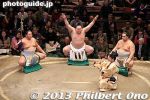
Yokozuna Hakuho from Mongolia performs the dohyo-iri ring-entering ceremony in Jan. 2013.
|
|
|
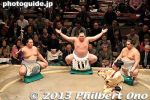
Yokozuna Hakuho
|
|
|
|
|
|
|
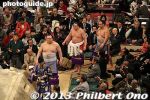
Next is Yokozuna Harumafuji.
|
|
|
|
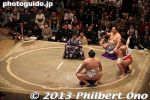
Yokozuna Harumafuji from Mongolia performs the dohyo-iri ring-entering ceremony.
|
|
|
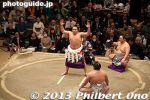
Yokozuna Harumafuji from Mongolia performs the dohyo-iri ring-entering ceremony.
|
|
|
|
|
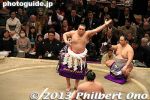
Yokozuna Harumafuji
|
|
|
|
|
|
|
|
|
|
|
|
|
|
|
|

Also on the first day of the tournament, the previous tournament winner receives a large portrait of himself to be hung in the Kokugikan. This is the ceremony for it.
|
|

In this case, Asashoryu receives a new portrait which is then unveiled. The portrait is usually sponsored by a major newspaper.
|
|
|
|

A portrait of Asashoryu is ceremoniously unveiled in the Kokugikan. On the right is the tournament date, on the left is the rikishi's name, and the sponsor's name is on the bottom. The portrait is actually B/W photo hand-painted in color.
|
|
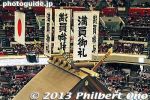
The "Full House" banners are unfurled above the Shinto-style roof.
|
|
|

And so the day's sumo matches continue as the wrestler walks up to the sumo ring to wait his turn.
|
|

The rikishi sits at ringside until his name is called by the yobidashi (caller or usher) here who is announcing the wrestler's name while holding a fan.
|
|
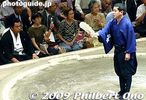
The yobidashi changes once in a while. Dressed in black and sitting as one of the judges is former yokozuna Chiyonofuji, now Kokonoe oyakata.
|
|

The two rikishi who were called up go on the ring and stomp their foot.
|
|

Then they rinse their mouths with water for purification. Another wrestler holds the water ladle and tissue paper.
|
|
|

They spit out the water into a small bucket in the corner.
|
|

Then they throw salt onto the ring for purification. They do this a few times before the match. These are all Shinto-based religious rituals. Even the roof above the sumo ring looks like a Shinto shrine roof.
|
|

Takamisakari does his "Robocop" act in his corner to psych himself up.
|
|

On the ring, they spread their arms to show that they carry no weapons.
|
|
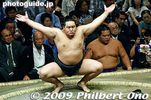
Asashoryu
|
|
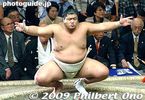
Musoyama (in Sept. 2004).
|
|

Many matches also have sponsor who pay money to the winner of the match. Each banner represents a sponsor.
|
|

Takamisakari
|
|

They glare at each other a few times before the match. They repeat the salt throwing and glaring for four minutes before the match starts.
|
|

The initial charge or tachiai is crucial, and can determine who will win the match. The rikishi on the right has charged earlier than the other, giving him the advantage.
|
|

Often the wrestlers will lock onto each other while gripping each other's mawashi belts (made of silk). (Ozeki Kaio vs. Tamanoshima in May 2005.)
|
|

There are many sumo techniques (called kimarite) to defeat the opponent. This is okuridashi or rear push out. Once your back is toward the opponent, you have little chance to recover.
|
|

Oshidashi or frontal push out, a common technique.
|
|

Overarm throw called uwatenage.
|
|

Sometimes a match is too close to call. The ringside judges will hold a conference in the ring and either decide who was the winner or declare a rematch. The referee must accept the decision. Judges in the video room may also examine a replay on video.
|
|

After losing, Takamisakari dejectedly leaves the ring. The crowd sympathizes with him and applaud.
|
|

Referees are also ranked. The higher ranking referees appear for the matches of the higher-ranking rikishi. They have different dress as the rank goes higher. The lowest-ranked referee may be barefoot.
|
|

The color of the tassel hanging from the referee's fan indicates his rank. Purple or purple and white indicates the highest ranking referee who judges the yokozuna matches. A red tassel is for the sanyaku matches (Ozeki, Sekiwake, Komusubi).
|
|

Kotooshu is from Bulgaria.
|
|

He defeats his opponent who also pushes down the referee.
|
|

The referee is thrown into the crowd by the wrestler (by accident, of course). An attendant carries the water bucket out of the way so the referee does not crash into it and spill the water. A judge looks on concerned, while some spectators are amused.
|
|

Once in a while, they freshen up the sumo ring, sweeping it.
|
|

Kotooshu on the right.
|
|
|

The wrestler must start the match from a "three-point stand" position where both his feet and at least one of his hands are touching the ground.
|
|
|

Trying for a yorikiri or frontal push out while grabbing the belt.
|
|
|

Grabbing the opponent's mawashi belt to throw him down or out is a key technique.
|
|

The referee points his fan toward the side of the winner.
|
|

Kokkai on the left. He is from Georgia in eastern Europe.
|
|

Kokkai means "Black Sea."
|
|

Both tumble off the ring...
|
|

And into the front row of spectators. I've never heard of any spectators who got injured by sumo wrestlers falling on top of them.
|
|

There were also two Russian sumo wrestlers. Roho and his brother Hakurozan. This is Roho in May 2005. Both got busted for drug use in 2008 and were kicked out of sumo.
|
|

Roho vs. Tochiazuma
|
|

Seeing sumo live is much better than seeing it on TV. The atmosphere can't be beat when you're actually there. Taking photos and videos are of course permitted.
|
|

Roho vs. Tochiazuma
|
|

Hakurozan on the right in Jan. 2006.
|
|

Hakurozan at the initial charge.
|
|

A large cushion is brought in for Kotooshu.
|
|

Kotooshu sits on his own cushion at ringside before his bout.
|
|

Besides Europeans, there are numerous Mongolians in sumo. This is Hakuho in May 2005. He's now a yokozuna.
|
|

Hakuho
|
|

Hakuho throws salt on the sumo ring.
|
|
|

Ama, another Mongolian and now Yokozuna Harumafuji. The Mongolians are taking over the top echelons of sumo dominated by foreigners. We haven't had a Japanese yokozuna since 2003.
|
|

The most famous Mongolian sumo wrestler is Asashoryu who has been quite controversial at times.
|
|
|
|
|
|

Asashoryu won this one.
|
|
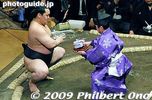
Asashoryu collects a big paycheck.
|
|

Sumo scoreboard. The names of all the wrestlers are displayed in the order of the sumo matches (from right to left). The winner is indicated with a red lamp.
|
|

Another match with Asashoryu.
|
|

Lots of sponsors for this match between Asashoryu and Hakuho on Jan. 19, 2006. Both Mongolians.
|
|

Asashoryu
|
|

Asashoryu and Hakuho glare at each other.
|
|
|
|

A false start by Hakuho.
|
|

If you want to photograph sumo, you'll need a good telephoto lens. The sumo ring has mostly tungsten lighting.
|
|
|

There goes Asashoryu.
|
|

The striking yokozuna upset makes the crowd go wild as they throw zabuton cushions in glee.
|
|

Hakuho collects his pay.
|
|

The cushions are quickly cleared away.
|
|
|
|

The thrown cushions are hastily piled up at ringside.
|
|
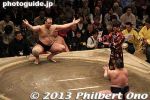
Ozeki Kotooshu in Jan 2013.
|
|
|
|
|
|
|
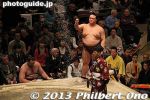
Ozeki Kisenosato
|
|
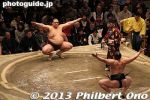
Ozeki Kisenosato vs. Yokozuna Harumafuji in Jan. 2013.
|
|
|
|
|
|
|
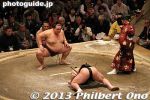
Harumafuji doing his very low stance.
|
|
|
|
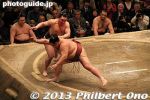
Harumafuji's common technique is to sidestep his opponent and push him out from behind.
|
|
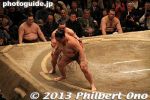
Kisenosato loses this one.
|
|
|
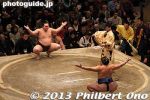
Yokozuna Hakuho vs. Ozeki Kakuryu in Jan 2013. They are both Mongolian.
|
|
|
|
|
|
|
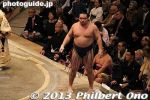
Ozeki Kakuryu in an 2013.
|
|
|
|
|
|
|
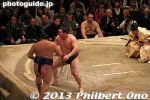
Hakuho beats Kakuryu.
|
|
|

Bow twirling (called Yumitori-shiki) is the final ceremony at the end of the tournament day which is around 6 pm.
|
|
|
|
|
|
|
|
|